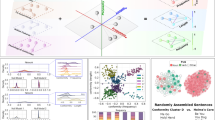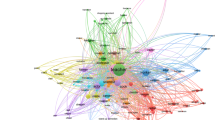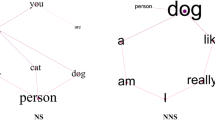Abstract
Understanding language learning and more general knowledge acquisition requires the characterization of inherently qualitative structures. Recent work has applied network science to this task by creating semantic feature networks, in which words correspond to nodes and connections correspond to shared features, and then by characterizing the structure of strongly interrelated groups of words. However, the importance of sparse portions of the semantic network—knowledge gaps—remains unexplored. Using applied topology, we query the prevalence of knowledge gaps, which we propose manifest as cavities in the growing semantic feature network of toddlers. We detect topological cavities of multiple dimensions and find that, despite word order variation, the global organization remains similar. We also show that nodal network measures correlate with filling cavities better than basic lexical properties. Finally, we discuss the importance of semantic feature network topology in language learning and speculate that the progression through knowledge gaps may be a robust feature of knowledge acquisition.
This is a preview of subscription content, access via your institution
Access options
Access Nature and 54 other Nature Portfolio journals
Get Nature+, our best-value online-access subscription
$29.99 / 30 days
cancel any time
Subscribe to this journal
Receive 12 digital issues and online access to articles
$119.00 per year
only $9.92 per issue
Buy this article
- Purchase on Springer Link
- Instant access to full article PDF
Prices may be subject to local taxes which are calculated during checkout






Similar content being viewed by others
References
Duff, F. J. & Hulme, C. The role of children’s phonological and semantic knowledge in learning to read words. Sci. Stud. Read. 16, 504–525 (2012).
Ambridge, B., Kidd, E., Rowland, C. F. & Theakston, A. L. The ubiquity of frequency effects in first language acquisition. J. Child Lang. 42, 239–273 (2015).
Karuza, E. A., Thompson-Schill, S. L. & Bassett, D. S. Local patterns to global architectures: influences of network topology on human learning. Trends Cogn. Sci. 20, 629–640 (2016).
Hills, T. T., Maouene, M., Maouene, J., Sheya, A. & Smith, L. Longitudinal analysis of early semantic networks—preferential attachment or preferential acquisition? Psychol. Sci. 20, 729–739 (2009).
Goldstein, R. & Vitevitch, M. S. The influence of clustering coefficient on word-learning: how groups of similar sounding words facilitate acquisition. Front. Psychol. 5, 1307 (2014).
Steyvers, M. & Tenenbaum, J. B. The large-scale structure of semantic networks: statistical analyses and a model of semantic growth. Cogn. Sci. 29, 41–78 (2005).
Hills, T. T., Maouene, J., Riordan, B. & Smith, L. B. The associative structure of language: contextual diversity in early word learning. J. Mem. Lang. 63, 259–273 (2010).
Hills, T. The company that words keep: comparing the statistical structure of child- versus adult-directed language. J. Child Lang. 40, 586–604 (2013).
Stella, M., Beckage, N. M., Brede, M. & De Domenico, M. Multiplex model of mental lexicon reveals explosive learning in humans. Sci. Rep. 8, 2259 (2018).
Giusti, C., Pastalkova, E., Curto, C. & Itskov, V. Clique topology reveals intrinsic geometric structure in neural correlations. Proc. Natl Acad. Sci. USA 112, 13455–13460 (2015).
Petri, G., Scolamiero, M., Donato, I. & Vaccarino, F. Topological strata of weighted complex networks. PLoS ONE 8, e66506 (2013).
Petri, G., Scolamiero, M., Donato, I. & Vaccarino, F. Networks and cycles: a persistent homology approach to complex networks. In Proc. European Conference on Complex Systems 2012 93–99 (Springer, 2013).
Carlsson, G. Topology and data. Bull. Amer. Math. Soc. 46, 255–308 (2009).
Zomorodian, A. & Carlsson, G. Computing persistent homology. Discrete Comput. Geom. 33, 249–274 (2005).
Frank, M. C., Braginsky, M., Yurovsky, D. & Marchman, V. A. Wordbank: an open repository for developmental vocabulary data. J. Child Lang. 44, 677–694 (2017).
McRae, K., Cree, G. S., Seidenberg, M. S. & McNorgan, C. Semantic feature production norms for a large set of living and nonliving things. Behav. Res. Methods 37, 547–559 (2005).
Engelthaler, T. & Hills, T. T. Feature biases in early word learning: network distinctiveness predicts age of acquisition. Cogn. Sci. 41, 120–140 (2017).
Bilson, S., Yoshida, H., Tran, C. D., Woods, E. A. & Hills, T. T. Semantic facilitation in bilingual first language acquisition. Cognition 140, 122–134 (2015).
Bender, E. A. & Canfield, E. R. The asymptotic number of labeled graphs with given degree sequences. J. Comb. Theory A 24, 296–307 (1978).
Maslov, S. & Sneppen, K. Specificity and stability in topology of protein networks. Science 296, 910–913 (2002).
Hoff, E. & Tian, C. Socioeconomic status and cultural influences on language. J. Commun. Disord. 38, 271–278 (2005).
Schwab, J. F. & Lew-Williams, C. Language learning, socioeconomic status, and child-directed speech. Wiley Interdiscip. Rev. Cogn. Sci. 7, 264–275 (2016).
Beckage, N., Smith, L. & Hills, T. Small worlds and semantic network growth in typical and late talkers. PLoS ONE 6, e19348 (2011).
Jimenez, E. & Hills, T. Network analysis of a large sample of typical and late talkers. In Proc. 39th Annual Meeting Cognitive Science Society 2302–2307 (Cognitive Science Society, 2017).
Dollaghan, C. A. et al. Maternal education and measures of early speech and language. J. Speech Lang. Hear. Res. 42, 1432–1443 (1999).
Nagy, W. E., Anderson, R. C. & Herman, P. A. Learning word meanings from context during normal reading. Amer. Educ. Res. J. 24, 237–270 (1987).
Goodman, J. C., Dale, P. S. & Li, P. Does frequency count? Parental input and the acquisition of vocabulary. J. Child Lang. 35, 515–531 (2008).
Arbesman, S., Strogatz, S. H. & Vitevitch, M. S. The structure of phonological networks across multiple languages. Int. J. Bifurcat. Chaos 20, 679–685 (2010).
Siew, C. S. Q. Community structure in the phonological network. Front. Psychol. 4, 553 (2013).
Corominas-Murtra, B., Valverde, S. & Sole, R. The ontogeny of scale-free syntax networks: phase transitions in early language acquisition. Adv. Complex Syst. 12, 371–392 (2009).
Čech, R. & Mačutek, J. Word form and lemma syntactic dependency networks in Czech: a comparative study. Glottometrics 19, 85–98 (2009).
Brent, M. R. & Siskind, J. M. The role of exposure to isolated words in early vocabulary development. Cognition 81, B33–B44 (2001).
Huttenlocher, J., Haight, W., Bryk, A., Seltzer, M. & Lyons, T. Early vocabulary growth: relation to language input and gender. Dev. Psychol. 27, 236–248 (1991).
Hart, B. & Risley, T. R. Meaningful Differences in the Everyday Experience of Young American Children (Brookes, Baltimore, MD, 1995).
Storkel, H. L. Developmental differences in the effects of phonological, lexical and semantic variables on word learning by infants. J. Child Lang. 36, 291–321 (2009).
Storkel, H. L. Learning new words: phonotactic probability in language development. J. Speech Lang. Hear. Res. 44, 1321–1337 (2001).
Hirsh-Pasek, K. et al. The contribution of early communication quality to low-income children’s language success. Psychol. Sci. 26, 1071–1083 (2015).
Youn, H. et al. On the universal structure of human lexical semantics. Proc. Natl Acad. Sci. USA 113, 1766–1771 (2016).
Goddard, C. (ed.) Cross-Linguistic Semantics, Vol. 102 (John Benjamins, Amsterdam, 2008).
Solé, R. V. & Seoane, L. F. Ambiguity in language networks. Linguist. Rev. 32, 5–35 (2015).
Hills, T. T., Maouene, M., Maouene, J., Sheya, A. & Smith, L. Categorical structure among shared features in networks of early-learned nouns. Cognition 112, 381–396 (2009).
Cancho, R. F. & Solé, R. V. The small world of human language. Proc. R. Soc. Lond. B 268, 2261–2265 (2001).
Taylor, D. et al. Topological data analysis of contagion maps for examining spreading processes on networks. Nature Commun. 6, 7723 (2015).
Papadopoulos, L. et al. Embedding of biological distribution networks with differing environmental constraints. Preprint at https://arxiv.org/abs/1612.08058 (2016).
Jin, E. M., Girvan, M. & Newman, M. E. J. Structure of growing social networks. Phys. Rev. E 64, 046132 (2001).
Holme, P. & Saramäki, J. Temporal networks. Phys. Rep. 519, 97–125 (2012).
Chowdhury, S. & Mémoli, F. A functorial Dowker theorem and persistent homology of asymmetric networks. Preprint at https://arxiv.org/abs/1608.05432 (2018).
Sizemore, A. E. & Bassett, D. S. Dynamic graph metrics: tutorial, toolbox, and tale. NeuroImage https://doi.org/10.1016/j.neuroimage.2017.06.081 (2017).
Hofer, C., Kwitt, R., Niethammer, M. & Uhl, A. Deep learning with topological signatures. Preprint at https://arxiv.org/abs/1707.04041 (2018).
Courtney, O. T. & Bianconi, G. Weighted growing simplicial complexes. Phys. Rev. E 95, 062301 (2017).
Palla, G., Derényi, I., Farkas, I. & Vicsek, T. Uncovering the overlapping community structure of complex networks in nature and society. Nature 435, 814–818 (2005).
Aldous, D. J. in École d’Été de Probabilités de Saint-Flour XIII—1983 (ed. Hennequin, P. L.) 1–198 (Vol. 1117, Lecture Notes in Mathematics, Springer, Berlin, 1985).
Hoover, D. N. Relations on Probability Spaces and Arrays of Random Variables (Institute for Advanced Study, 1979).
Bianconi, G. & Rahmede, C. Emergent hyperbolic network geometry. Preprint at https://arxiv.org/abs/1607.05710 (2016).
Kahle, M. et al. Limit the theorems for Betti numbers of random simplicial complexes. Homol. Homotopy Appl. 15, 343–374 (2013).
Bendich, P., Bubenik, P. & Wagner, A. Stabilizing the unstable output of persistent homology computations. Preprint at https://arxiv.org/abs/1512.01700 (2017).
Mišić, B. et al. Cooperative and competitive spreading dynamics on the human connectome. Neuron 86, 1518–1529 (2015).
Vinayagam, A.et al. A directed protein interaction network for investigating intracellular signal transduction. Sci. Signal. 4, RS8 (2011).
Bassett, D. S., Owens, E. T., Daniels, K. E. & Porter, M. A. Influence of network topology on sound propagation in granular materials. Phys. Rev. E 86, 041306 (2012).
Cockrell, G. M. et al. New paradigm for allosteric regulation of Escherichia coli aspartate transcarbamoylase. Biochemistry 52, 8036–8047 (2013).
Dale, P. S. & Fenson, L. Lexical development norms for young children. Behav. Res. Meth. Instr. Comp. 28, 125–127 (1996).
Barsalou, L. W. Abstraction in perceptual symbol systems. Philos. Trans. R. Soc. Lond. B 358, 1177–1187 (2003).
Hampton, J. A. Polymorphous concepts in semantic memory. J. Verb. Learn. Verb. Behav. 18, 441–461 (1979).
Wu, L.-l. & Barsalou, L. W. Perceptual simulation in conceptual combination: evidence from property generation. Acta Psychol. 132, 173–189 (2009).
Devlin, J. T., Gonnerman, L. M., Andersen, E. S. & Seidenberg, M. S. Category-specific semantic deficits in focal and widespread brain damage: a computational account. J. Cogn. Neurosci. 10, 77–94 (1998).
Moss, H. E., Tyler, L. K. & Devlin J. T. in Category Specificity in Brain and Mind (eds Forde, E. & Humphreys, G.) 115–148 (Psychology Press, Hove, 2002).
Ghrist, R. Barcodes: the persistent topology of data. Bull. Am. Math. Soc. 45, 61–75 (2008).
Henselman, G. & Ghrist, R. Matroid filtrations and computational persistent homology. Preprint at https://arxiv.org/abs/1606.00199 (2017).
Rubinov, M. & Sporns, O. Complex network measures of brain connectivity: uses and interpretations. NeuroImage 52, 1059–1069 (2010).
Watts, D. J. & Strogatz, S. H. Collective dynamics of small-world networks. Nature 393, 440–442 (1998).
Kintali, S. Betweenness centrality: algorithms and lower bounds. Preprint at https://arxiv.org/abs/0809.1906 (2008).
Acknowledgements
The authors thank L. Torres, T. Eliassi-Rad and B. Klein for discussions. This work was supported by the National Science Foundation CAREER PHY-1554488 to D.S.B. The authors also acknowledge support from the John D. and Catherine T. MacArthur Foundation, the Alfred P. Sloan Foundation, the Paul G. Allen Foundation, the Army Research Laboratory through contract number W911NF-10-2-0022, the Army Research Office through contract numbers W911NF-14-1-0679 and W911NF-16-1-0474, the National Institute of Health (2-R01-DC-009209-11, 1R01HD086888-01, R01-MH107235, R01-MH107703, R01MH109520, 1R01NS099348 and R21-M MH-106799), the Office of Naval Research and the National Science Foundation (BCS-1441502, CAREER PHY-1554488, BCS-1631550 and CNS-1626008). The content is solely the responsibility of the authors and does not necessarily represent the official views of any of the funding agencies. The funders had no role in study design, data collection and analysis, decision to publish or preparation of the manuscript.
Author information
Authors and Affiliations
Contributions
A.E.S. and D.S.B. devised the experiments. A.E.S. performed the data analysis and crafted the initial draft. All authors revised the manuscript and approved the final version.
Corresponding author
Ethics declarations
Competing interests
The authors declare no competing interests.
Additional information
Publisher’s note: Springer Nature remains neutral with regard to jurisdictional claims in published maps and institutional affiliations.
Supplementary information
Supplementary Information
Supplementary Methods, Supplementary Notes, and Supplementary Figures 1–11
Rights and permissions
About this article
Cite this article
Sizemore, A.E., Karuza, E.A., Giusti, C. et al. Knowledge gaps in the early growth of semantic feature networks. Nat Hum Behav 2, 682–692 (2018). https://doi.org/10.1038/s41562-018-0422-4
Received:
Accepted:
Published:
Issue Date:
DOI: https://doi.org/10.1038/s41562-018-0422-4
This article is cited by
-
Feature-rich multiplex lexical networks reveal mental strategies of early language learning
Scientific Reports (2023)
-
Ramsey’s Theory Meets the Human Brain Connectome
Neural Processing Letters (2023)
-
Stability of synchronization in simplicial complexes
Nature Communications (2021)
-
Growing scale-free simplices
Communications Physics (2021)
-
Feature distinctiveness effects in language acquisition and lexical processing: Insights from megastudies
Cognitive Processing (2020)



